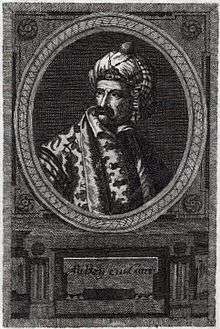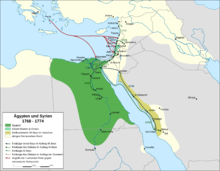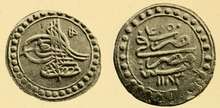Ali Bey al-Kabir
Ali Bey al-Kabir (Mgebrishvili) (Arabic: علي بك الكبير) (1728–1773) was a Mamluk leader in Egypt. Nicknamed Jinn Ali ("Ali the Devil") and Bulut Kapan ("Cloud-Catcher"),[1] Ali Bey rose to prominence in 1768 when he rebelled against his Ottoman rulers, making the Egypt Eyalet of the Ottoman Empire independent for a short time. His rule ended following the insubordination of his most trusted general, Abu al-Dahab, which led to Ali Bey's downfall and death.
Ali Bey al-Kabir (Mgebrishvili) | |
|---|---|
 Ali Bey al-Kabir (1728–1773) | |
| Born | 1728[1] |
| Died | 8 May 1773[1] |
| Burial place | Qarafa al-Sughra[1] |
| Other names | Jinn Ali, Bulut Kapan[1] |

Life

Ali Bey was born in Georgia and was of ethnic Georgian origin.[lower-alpha 1][1][lower-alpha 2][2] The Encyclopedia of Islam adds that according to Ali Bey's contemporary biographer, Sauveur Lusignan, he was "supposedly" the son of a certain David, a Greek Orthodox priest.[1] However, according to Alexander Mikaberidze, Ali Bey's father was a priest in the Georgian Orthodox Church.[3][lower-alpha 3] He was kidnapped and brought to Cairo in 1743 where he was sold into slavery. He was recruited into the Mamluk force in which he gradually rose in ranks and influence, winning the top office of Shaykh al-Balad (chief of the country) in 1760. Attempting to gain complete control, he sought to exile his rival Abd el-Rahman in 1762 when the latter was conducting the caravan of Mecca, but was instead sentenced to exile at Gaza; Ali Bey started for that city, but on the third day made to the Hijaz where he was joined by a number of his followers, and from there travelled to Girga where he spent the next two years, until his supporters in Cairo effected his recall.[5]
"During his time in power, he successfully expanded Egypt's trade with Britain and France. He also hired European advisers to the military and bought European weapons".[6]
However, "... he did not make use of native Egyptians or call in foreigners for technical advice. He made no effort to build a modern army..."[7]
In 1768, Ali Bey deposed the Ottoman governor Rakım Mehmed Pasha and assumed the post of acting governor.[8] He stopped the annual tribute to the Sublime Porte and in an unprecedented usurpation of the Ottoman Sultan's privileges had his name struck on local coins in 1769 (alongside the sultan's emblem), effectively declaring Egypt's independence from Ottoman rule. In 1770 he gained control of the Hijaz and a year later temporarily occupied Syria, thereby reconstituting the Mamluk state that had disappeared in 1517. However, a few days after a major victory over Governor Uthman Pasha al-Kurji by the allied forces of Zahir al-Umar and Ali Bey's forces on 6 June 1771, Abu al-Dhahab, the commander of his troops in Syria, refused to continue the fight after an Ottoman agent stirred up mistrust between him and Ali Bey, and hastily returned to Egypt.[9] As a result, Ali Bey lost power in 1772. The following year, he was killed in Cairo.[10][11]
However, the date of 1772 is highly disputed; other sources and historians give varying dates for the end of Ali Bey's power in Egypt. Uzunçarşılı claims that he held power until 1773 (when Kara Halil Pasha became governor), but Sicill-i Osmani disagrees, saying that he fell out of power in 1769 and naming three interceding governors by name between the end of Ali Bey's reign in 1769 and Kara Halil Pasha's appointment in 1773; these are Köprülü Hafız Ahmed Pasha (1769), Kelleci Osman Pasha (1769–1771), and Vekil Osman Pasha (1772–1773).[12] First-person source Al-Jabarti declares that Ali Bey gave up power in 1769 when a new governor from the Ottoman capital of Istanbul was assigned by the sultan (although he doesn't name him).[8] It is likely that Uzunçarşılı read Al-Jabarti's chronicle, but failed to note the narrative about the new governor coming from Istanbul in 1769, since after that, Al-Jabarti does not name any other pasha by name or sequence until 1773 with Kara Halil Pasha.[8]
See also
Notes
- Alī Bey al-Kabīr (c. 1140–87/1728–73), an Egyptian mamlūk of Georgian origin, rose to become one of the most powerful political figures of Egypt.[1]
- "The rebellious Ali Bey al-Kabir was Georgian..."[2]
- In his 2015 work (Historical Dictionary of Georgia), Mikaberidze mentions that Ali Bey was born into a family of orthodox Christians, without mentioning the specific Church.[4]
References
- Crecelius 2007.
- Hathaway & Barbir 2013, p. 99.
- Mikaberidze 2011, p. 83-84.
- Mikaberidze 2015, p. 112.
- Constantin-François Volney, Travels Through Syria and Egypt, in the Years 1783, 1784, and 1785, third edition (London, 1805), vol. 1 p. 111f
- William L Cleveland, Martin Bunton: A History of the modern middle east Cleveland, p.59. Westview Press 2009
- Robin Leonard Bidwell: Dictionary of Modern Arab History, p. 24f. Paul Kegan International, London/New York 1998
- 'Abd al-Rahman Jabarti; Thomas Philipp; Moshe Perlmann (1994). Abd Al-Rahmann Al-Jabarti's History of Egypt. 1. Franz Steiner Verlag Stuttgart. p. 513.
- Volney, Travels, vol. 1 pp. 119 - 122.
- Sicker, Martin (2001), The Islamic world in decline: from the Treaty of Karlowitz to the disintegration of the Ottoman Empire, pp. 83-85. Greenwood Publishing Group, ISBN 0-275-96891-X
- Sayyid-Marsot, Afaf Lutfi (2007), A history of Egypt: from the Arab conquest to the present, pp. 57-59. Cambridge University Press, ISBN 0-521-70076-0
- Mehmet Süreyya (1996) [1890], Nuri Akbayar; Seyit A. Kahraman (eds.), Sicill-i Osmanî (in Turkish), Beşiktaş, Istanbul: Türkiye Kültür Bakanlığı and Türkiye Ekonomik ve Toplumsal Tarih Vakfı, ISBN 9789753330411
Sources
- Crecelius, Daniel (2007). "ʿAlī Bey al- Kabīr". Encyclopaedia of Islam 3. doi:10.1163/1573-3912_ei3_SIM_0207.CS1 maint: ref=harv (link)
- Hathaway, Jane; Barbir, Karl (2013). The Arab Lands under Ottoman Rule: 1516-1800. Routledge.CS1 maint: ref=harv (link)
- Mikaberidze, Alexander (2011). "Ali Bey al-Kabir". In Mikaberidze, Alexander (ed.). Conflict and Conquest in the Islamic World: A Historical Encyclopedia. Vol. I. ABC-CLIO.CS1 maint: ref=harv (link)
- Mikaberidze, Alexander (2015). Historical Dictionary of Georgia (2 ed.). Rowman & Littlefield. ISBN 978-1442241466.CS1 maint: ref=harv (link)
Further reading
- Virginia H. Aksan,. Ottoman Wars, 1700–1870: An Empire Besieged, (Routledge, 2013), 234.
Literature
- Sauveur Lusignan: A history of the Revolution of Ali Bey against the Ottoman Porte. London 1783